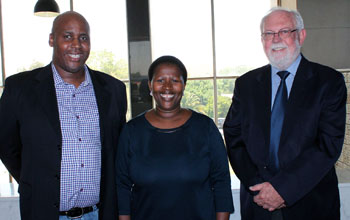
From the left are: Tshepo Moremi (Deputy Director-General), Mamotena Puleni (Personal Assistant to the Deputy Director-General) and Prof Maitland Seaman (Head of Department: Centre for Environmental Management). Photo: Ifa Tshishonge |
As part of celebrating 20 years of existence, the Centre for Environmental Management at the University of the Free State (UFS) hosted a public lecture themed, ‘The Future of Environmental Management’. Mr Tshepo Moremi, Deputy Director-General of the Department of Environmental Affairs and Tourism (Free State), portfolio Environment, Conservation and Tourism, delivered this lecture.
Mr Moremi said, “The environmental performance of South Africa must be seen in the context of our history and the country’s transition. South Africa has taken the lead in being a responsible global citizen, and we also participate in international projects in this field.”
South Africa hosts one of the richest biodiversities in the world. However, the country’s economy is still very energy - and carbon intensive.
“According to the World Health Organisation, approximately 16% of all deaths and one-third of diseases in children under the age of five years are environmentally related. Inadequate sanitation and indoor pollution are key factors,” Mr Moremi said.
“Academic institutions like the UFS and the government need to take the role of equipping citizens with skills and training so that we can overcome the challenges and seize opportunities related to the environment.
“Financing mechanisms for projects related to environmental sustainability were introduced in 2011. However, we still lack skilled capacity to run these projects smoothly and to use international and national funding strategically.
“Looking forward and responding to our challenges, it is vital that we transform our economy to be an international competitor and job-creation hub, and to be sustainably climate resilient, as outlined by the National Development Plan. Minimum standards will also be put in place to regulate emissions and monitor air quality. The sustainability of society’s well-being is important to the long-term role of environmental management in boosting our socio-economic status as a nation,” Mr Moremi said.
He emphasised that it must not only be about conserving and preserving. “Our people should benefit economically and socially,” he said.
Mr Moremi encouraged the audience to defend ideas that protect our non-speaking natural resources. “Let’s all do what we can and rise to this advocacy challenge,” he added. He also expressed his gratitude towards the university for honouring him during such a celebration and for working together in advocating for environmental issues.
The Centre for Environmental Management also hosted a strategic colloquium, discussing issues such as demography, resources, climate, water, environmental management, academic pursuance, as well as curriculum and the role of professional registration which may have an influence on the nature of its programmes.